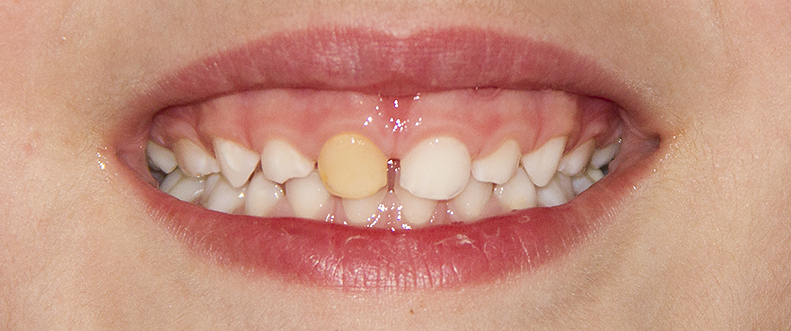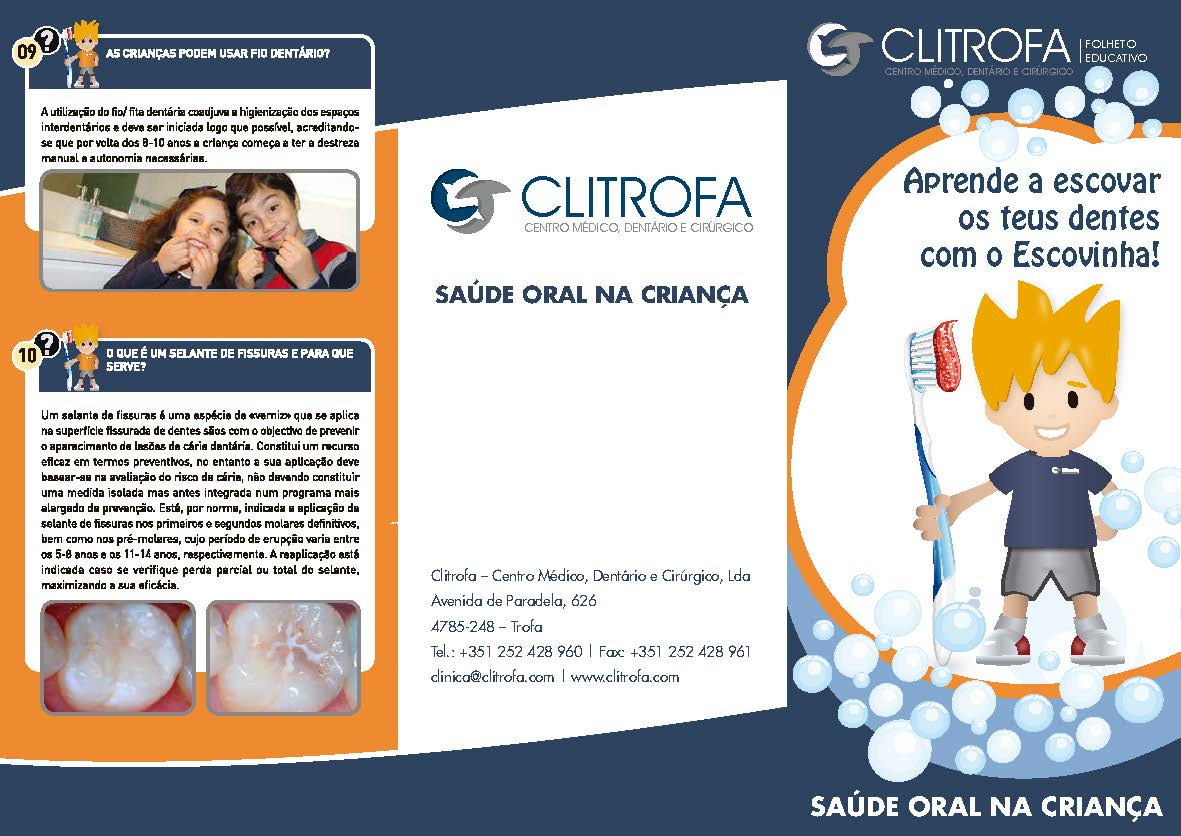Pediatric Dentistry
Pediatric Dentistry is the area of dental medicine dedicated to the oral health of babies, children and adolescents and whose main objective is to carry out preventive but also curative treatments so that the child reaches adulthood with a healthy, aesthetic and functional mouth.




Oral health in children
1 – At what age and how often should the child see a dentist?
The first consultation should be carried out when the first temporary (or milk) teeth erupt or, at most, until the child completes the first year of life, in order to establish a preventive oral health program and to intercept habits that may be harmful.
Ideally, when there is good oral health, the child should be seen every 6 months. In situations of high risk of caries this periodicity should be reduced to intervals of 3 months.
2 – At what age do the first teeth appear and when are the dentitions completed?
On average, the eruption of the first dentition begins between 6 and 8 months of age, with girls generally being more precocious and completing their dentition between 2 ½ years and 3 years of age.
3 – What complaints can be related to the eruption of teeth and how can the child be helped?
The most common symptoms are: red gums, increased salivation, loss of appetite and changes in nutritional habits, anxiety, difficulty sleeping. If your child has a fever, vomiting or diarrhea, you should be consulted by your attending physician as there may be another underlying cause. The child’s discomfort can be alleviated by cleaning the mouth 2-3 times a day with wet gauze or using commercially available teethers and gels.

4 – When should the use of pacifiers, bottles or digital suction cease?
Non-nutritive sucking habits (pacifiers, for example) should be abandoned until about 3 years of age, taking into account the possibility of self-correction of disharmony in the development of dental arches. Regarding the bottle, the habit should be abandoned, ideally, when the child turns 1 year old.
Some methods can provide added value, namely gradually dilute the contents of the bottle in water, so that after 2 weeks the child is offered only water; another way is to gradually reduce the amount of fluid until the habit stops, with the bottle being replaced, for example, by the glass with straw or spoon.
5 – How can early childhood cavities be prevented?
Several measures are important in preventing caries injuries in early childhood: promoting breastfeeding at least until 4-6 months of age, putting only milk or water in the bottle and offering the child especially during the day and never when sleeping; do not put sugary liquids in the bottle or the pacifier; as soon as the first teeth erupt, promote your hygiene with a gauze, fingertip or soft brush, ideally after meals.
6 – What are the most frequent causes for the occurrence of dental color changes in a child?
The color change can have several causes. Thus, in addition to caries lesions, traumatic situations, disturbances in the formation of enamel and dentin, deficient oral hygiene or extrinsic pigmentation of bacterial or alimentary origin, for example, can lead to this type of disorders. The dentist will be responsible for the correct diagnosis and eventual intervention.

7 – Deve administrar-se flúor às crianças?
A administração de flúor às crianças tem sido alvo de controvérsia. Face à evidência disponível, e de acordo com as recomendações da Direcção Geral de Saúde, é dada prioridade às aplicações tópicas sob a forma de dentífrico administrados na escovagem dos dentes desde a sua erupção. Os comprimidos e gotas anteriormente recomendados só serão administrados após os três anos a crianças de alto risco à cárie dentária. Nesta situação, os comprimidos devem ser dissolvidos na boca, lentamente, preferencialmente antes de deitar. As acções de educação para a saúde devem, prioritariamente, promover a escovagem dos dentes com dentífrico fluoretado.
8 – How should tooth brushing be performed on children?
The characteristics of brushing in a child are dependent on several factors, but essentially on the child’s age. Thus, according to the rules of the General Directorate of Health:
- 0 – 3 years: brushing performed by the parents after the eruption of the first tooth, twice a day (once mandatory at bedtime) using a gauze, finger pin or soft brush, also suitable;
- 3 – 6 years: brushing carried out progressively by the child, duly supervised and assisted, twice a day (one of which must be at bedtime), using a soft brush, also suitable. The amount of fluoride toothpaste (1000 – 1500 ppm) should be similar to the size of the nail on the child’s fifth finger;
- > 6 years: brushing performed by the child, duly supervised and assisted if he does not have sufficient manual dexterity, twice a day (one of which is mandatory at bedtime), using a soft brush (or alternatively medium). The amount of fluoride toothpaste (1000 – 1500 ppm) should be the size of a small pea or up to 1 cm of toothpaste.


9 – Can children use dental floss?
The use of dental floss / tape helps to clean the interdental spaces and should be started as soon as possible, believing that around 8 – 10 years old the child begins to have the necessary manual dexterity and autonomy.


10 – What is a crack sealant and what is it for?
A crack sealant is a kind of “varnish” that is applied to the cracked surface of healthy teeth in order to prevent the appearance of dental caries lesions. It constitutes an effective resource in preventive terms, however its application must be based on the assessment of the risk of caries, and should not constitute an isolated measure but integrated into a broader prevention program. As a rule, the application of crack sealant in the first and second permanent molars is indicated, as well as in the premolars, whose eruption period varies between 5-8 years and 11-14 years, respectively.
Replication is indicated if there is partial or total loss of the sealant, maximizing its effectiveness.

